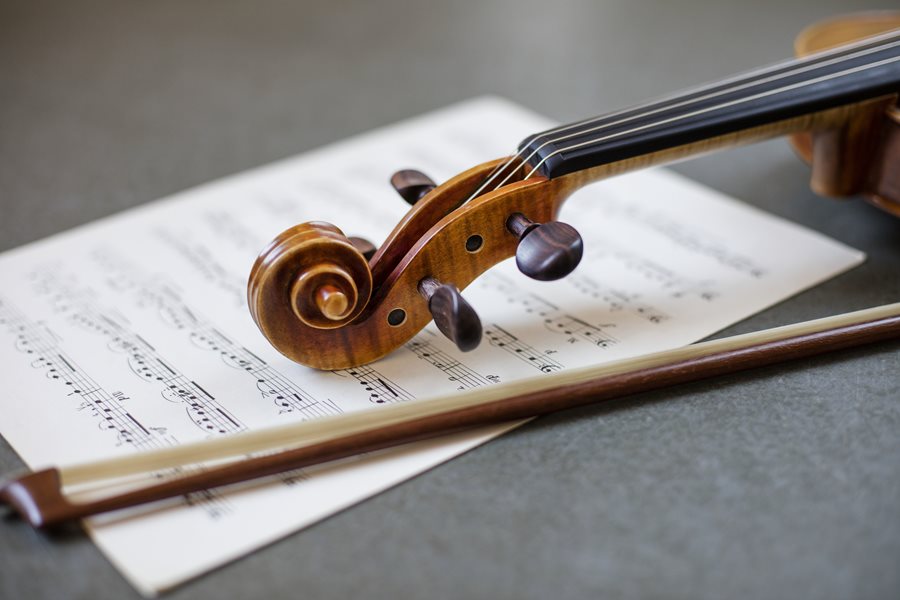_1.jpg?branch=web_prod)
Perfect Pitch: Do You Have It?

Perfect Pitch: Do You Have It?
10 min.
Publication Date: 18 August 2023
Have you ever marvelled at someone's ability to effortlessly identify or reproduce musical notes without any external reference? This remarkable skill is known as perfect pitch, and it is highly coveted among musicians and music enthusiasts. In this article, we will delve into the concept of perfect pitch, explore its different forms, discuss its rarity, examine whether it is an innate ability or a learned skill, and explore how it can be tested. Additionally, we will touch upon the relationship between perfect pitch, hearing loss and speech perception.
Overview:
- Absolute and Relative Pitch: What is the Difference?
- Is Perfect Pitch Rare?
- Are You Born with Perfect Pitch or Is It Learned?
- Examples of Artists Known to Have Perfect Pitch
- How To Test for Perfect Pitch?
- Can You Have Perfect Pitch With a Hearing Loss or If You Wear a Hearing Device?
- What are Fundamental Frequency and Harmonics?
- Is Pitch Important for Speech Perception?
- Summary
- References

Absolute and Relative Pitch: What is the Difference?
Perfect pitch, also referred to as absolute pitch, is the ability to identify or reproduce musical notes accurately without the need for a reference pitch.3 Individuals with perfect pitch possess an inherent sense of pitch, enabling them to recognise and recall specific frequencies or musical tones. This means they can easily identify a note as being an A, C#, or any other pitch name without needing any external aid.4
In contrast, individuals with relative pitch rely on comparing pitches with a known reference point, such as a previously played note or a musical instrument.
Absolute pitch and relative pitch represent two distinct ways of perceiving and understanding musical pitch.
As mentioned before, absolute pitch refers to the ability to identify a note by name without any reference. On the other hand, relative pitch involves the ability to identify and understand the relationships between pitches.
Musicians with relative pitch can determine intervals, melodies, and chords by comparing them to a known starting point or key.
Is Perfect Pitch Rare?
Perfect pitch is generally considered a rare ability. It is estimated that only about 1 in 10,000 people possess perfect pitch.2
Research suggests that it is more common in individuals with a musical background, such as professional musicians or individuals who started music training at an early age. However, the exact causes and mechanisms behind the development of perfect pitch are still not fully understood.1
Are You Born with Perfect Pitch or Is It Learned?
The debate about whether perfect pitch is an innate ability or a learned skill continues.
Some studies suggest a genetic predisposition to perfect pitch, implying that individuals may be born with a greater likelihood of acquiring this ability.5However, environmental factors, such as early musical training and exposure to music, are also believed to play a significant role in its development.
It is thought that a combination of genetic and environmental factors contributes to the manifestation of perfect pitch.5
Examples of Artists Known to Have Perfect Pitch
Various renowned artists throughout history have been associated with perfect pitch. However, it is important to note that not all artists possess this ability.
Some notable figures rumored to have had perfect pitch include Ludwig van Beethoven and Wolfgang Amadeus Mozart, both celebrated classical composers. As for modern artists, Billie Eilish, Elvis Presley, and Michael Jackson have been cited as having perfect pitch.
However, it is worth mentioning that the availability of accurate historical documentation makes it difficult to definitively confirm the possession of perfect pitch by these artists.
How To Test for Perfect Pitch?
Testing for perfect pitch can be done through various methods:
- One common approach is the pitch-naming test, where individuals are played a series of isolated musical notes and asked to identify them by their respective pitch names.
- Another test involves reproducing a given note on a musical instrument without any reference pitch.
- Additionally, tests can include tasks like identifying intervals, chords, or melodies by ear.8
Can You Have Perfect Pitch With a Hearing Loss or If You Wear a Hearing Device?
Regarding the relationship between perfect pitch and hearing loss, studies suggest that individuals with hearing loss or who wear hearing aids may experience a decline in their perfect pitch abilities.6
However, the extent to which this occurs can vary depending on the severity and nature of the hearing loss.
In some cases, individuals may lose their perfect pitch entirely, while in others, it may be impaired but still present to some degree.
It is important to note that hearing loss does not necessarily guarantee a loss of perfect pitch, as individuals who develop perfect pitch before experiencing hearing loss may retain some level of this ability.
What are Fundamental Frequency and Harmonics?
Similar to the sounds from most musical instruments, voiced speech is formed by harmonic complex tones. These tones are made up of many pure tones (tones determined primarily by their frequency), called harmonics. Harmonic complex tones consist of several frequencies that are multiples of a single fundamental frequency (F0), which is the lowest frequency of a sound wave.
For example, if the F0 is 100 Hz (Hertz), the higher harmonics will be 200 Hz, 300 Hz, 400 Hz, and so on.
Is Pitch Important for Speech Perception?
Pitch is of course important for music perception, but it is also especially important for speech perception. It plays a crucial role in our ability to segregate sounds arriving from different sources, for example, two people talking at the same time.
Within the cochlea, the snail-shaped inner ear, lies the basilar membrane. This is the main mechanical element of the inner ear, which vibrates in response to incoming sound waves.
The mass and stiffness of the basilar membrane changes from the base to the apex of the cochlea. High-frequency (or high-pitched) sound produces maximal movement of the basilar membrane at the “base” of the cochlea (near the stapes - one of the three inner bones - see article on Understanding Ear Ossicles), whereas low-frequency sound vibrations travel up the length of the basilar membrane from the base, also activating the apical parts.7
The vibration patterns have the effect of separating incoming sound into its component frequencies that activate different cochlear regions. Each point along the cochlea's basilar membrane responds to a limited range of frequencies.
In listeners with hearing loss, pitch perception—both with pure tones and complex tones—is often poorer than normal.
Hearing impairment is often accompanied by poorer frequency selectivity along the basilar membrane. This means that 'auditory filters' along the membrane are broader, and hence frequency discrimination (i.e. deciding whether two tones have the same pitch or not) may be less precise. Discriminating loudness and processing timing or temporal aspects of speech sounds may also be affected by hearing loss.
That being said though, as with many auditory capabilities, there is large variability between different listeners.
Summary
In conclusion, perfect pitch, or absolute pitch, is a rare and highly sought-after ability that enables individuals to identify and reproduce musical notes accurately without external reference.
While perfect pitch is believed to have both genetic and environmental factors influencing its development, the exact mechanisms are not yet fully understood.
Notable artists throughout history, including Beethoven and Mozart, as well as contemporary musicians like Billie Eilish, Elvis Presley, and Michael Jackson, have been associated with perfect pitch.
Testing for perfect pitch involves various assessments that evaluate an individual's ability to recognise and reproduce pitches accurately.
Finally, the relationship between perfect pitch and hearing loss suggests that hearing impairment may affect perfect pitch abilities for both music and speech perception, but the degree of impact can vary from person to person.
References:
- Levitin, D. J., & Rogers, S. E. (2005). Absolute pitch: Perception, coding, and controversies. Trends in cognitive sciences, 9(1), 26-33.
- Gregersen, P. K., Kowalsky, E., Kohn, N., & Marvin, E. (1999). Absolute pitch: prevalence, ethnic variation, and estimation of the genetic component. American Journal of Human Genetics, 65(3), 911-913.
- Takeuchi, A. H., & Hulse, S. H. (1993). Absolute pitch. Psychological Bulletin, 113(2), 345-361.
- Miyazaki, K. (1988). Musical pitch identification by absolute pitch possessors. Perception & Psychophysics, 44(6), 501-512.
- Baharloo, S., Johnston, P. A., Service, S. K., Gitschier, J., & Freimer, N. B. (1998). Absolute pitch: an approach for identification of genetic and nongenetic components. American Journal of Human Genetics, 62(2), 224-231.
- Oxenham AJ. (2008). Pitch perception and auditory stream segregation: Implications for hearing loss and cochlear implants. Trends Amplif., Dec;12(4):316-31. doi: 10.1177/1084713808325881. Epub 2008 Oct 30. PMID: 18974203; PMCID: PMC2901529.
- Eggermont, J. (2017). Hearing Basics. Hearing Loss: Causes, Prevention and Treatment, Ch.1, 3-36.
- What is Perfect Pitch? (2018). Retrieved from https://www.3d-varius.com/what-is-perfect-pitch/ on 8 June 2023.
.png?branch=web_prod)
_1.jpg?branch=web_prod)
_1.jpg?branch=web_prod)
.png?branch=web_prod)